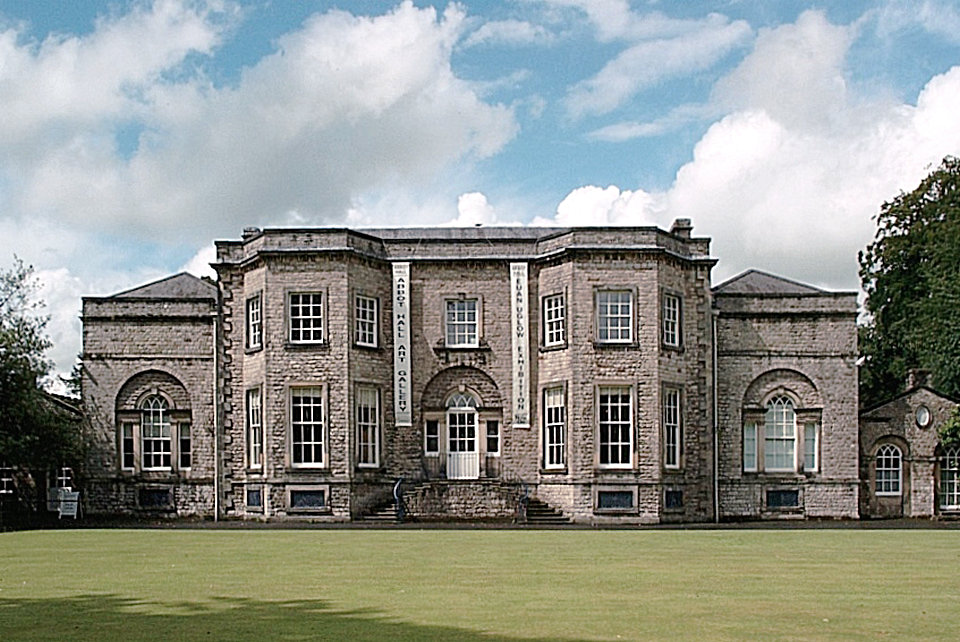Abbot Hall Art Gallery, Kendal, United Kingdom


Abbot Hall Art Gallery is a museum and gallery in Kendal, England. Abbot Hall was built in 1759 by Colonel George Wilson, the second son of Daniel Wilson of Dallam Tower, a large house and country estate nearby. It was built on the site of the old Abbot’s Hall, roughly where the museum is today. Before the Dissolution of the Monasteries this was where the Abbot or his representative would stay when visiting from the mother house of St Mary’s Abbey, York. The architect is unknown. During the early twentieth century the Grade I listed building was dilapidated and has been restored as an art gallery.
It has one of the most important collections of George Romney’s paintings in Britain and several of his sketchbooks and drawings. Paintings from the eighteenth century include a pair of views of Windermere by Philip James de Loutherbourg. There is also an important group of work by another local artist, Daniel Gardner. It has a significant collection of watercolours, mainly from the second half of the eighteenth and the first half of the nineteenth centuries. Many of the greatest watercolourists of the period are represented, including John Robert Cozens, David Cox, Peter De Wint, John Sell Cotman, John Varley and Edward Lear as well as J. M. W. Turner’s watercolours The Passage of Mount St. Gotthard and Windermere (1821).
In 2011 a triptych of Lady Anne Clifford, entitled The Great Picture (currently (2011) in the ownership of the Lakeland Arts Trust) went on display.
The Victorian art critic and social commentator, John Ruskin, lived in the Lake District and the gallery has one of the most comprehensive collections of his drawings and watercolours. The modern collection concentrates more on painting but has sculptures by Barbara Hepworth, Jean Arp, and Elisabeth Frink. There are also works by Ben Nicholson, Kurt Schwitters, Bryan Wynter, Sean Scully, David Hockney, LS Lowry, Graham Sutherland, Victor Pasmore, David Bomberg and many others.
The gallery also has a display about English writer Arthur Ransome. His desk, typewriter and other memorabilia are exhibited. The gallery is also the official address of The Arthur Ransome Society.
The Gallery is housed in one of Kendal’s most important buildings, a Grade I listed villa, on the banks of the River Kent. The galleries offer two floors of light-filled spaces in which to see art.
Abbot Hall has a comprehensive collection of George Romney’s work. His paintings are hung in the elegant historical settings for which they were painted, amongst fine 18th-century furniture and porcelain. Watercolours are shown in a small gallery reminiscent of a collector’s private room, with regularly changing displays that allow a Turner to be seen alongside a Ruskin or a Constable sketch next to works by the likes of Cotman, Cozens and Edward Lear.
Abbot Hall has been one of the most active galleries collecting British art in recent years and important works have been acquired, ranging from a Turner watercolour of Windermere to portraits by Stanley Spencer and abstract paintings by Bridget Riley and Sean Scully. Abbot Hall has also secured some spectacular long-term loans, including works by Constable, L. S. Lowry and Lucian Freud.
As well as a fine permanent collection, Abbot Hall is acknowledged as having one of the most imaginative and independently minded temporary exhibition programmes outside London.
The Museum takes you back through time to explore the story of the Lake District and its inhabitants. Isolated before the arrival of the railway and motorcar, this area developed its own unique customs and traditions. Recreated period rooms and workshops reveal how rural people lived and worked and played and how different life was before the introduction of machinery. Discover a Lake District kitchen, complete with traditional recipes and utensils, a bedroom full of vernacular furniture and furnishings – including a magnificent 17th century four-poster bed, a farmhouse parlour with a working phonograph and rare 18th century oak panelling.